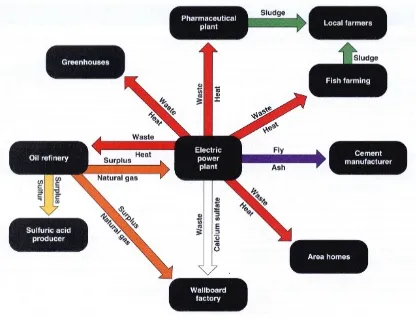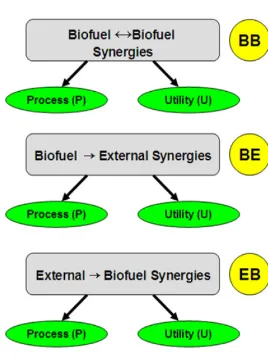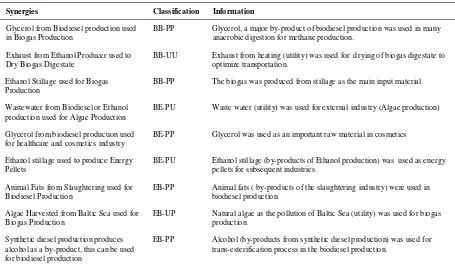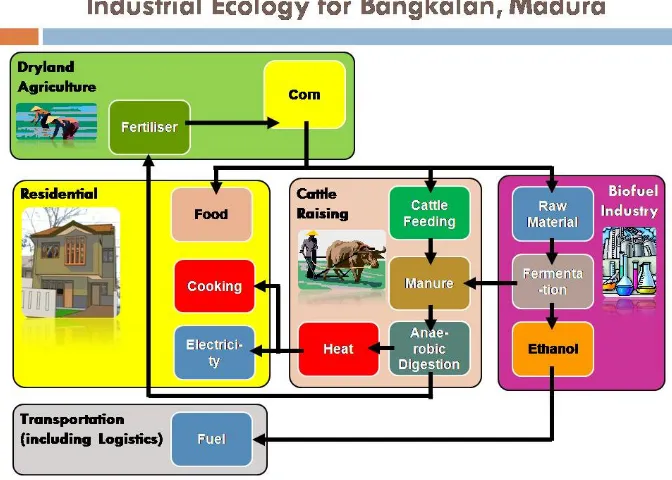ScienceDirect
Procedia - Social and Behavioral Sciences 00 (2016) 000–000
www.elsevier.com/locate/procedia
1877-0428 © 2016 The Authors. Published by Elsevier Ltd.
Peer-review under responsibility of the organizing committee of CITIES 2015.
CITIES 2016 International Conference, Coastal Planning for Sustainable Marine Development,
CITIES 2016, 18
thOctober 2016, Surabaya, Indonesia
Sustainable Agro-Industrial Ecology Concept of the Madura Island
Joyce Martha Widjaya
a, Gunawan Tanuwidjaja
b*
a Research Institute of Policy and Technology Implementation (Pusat Penelitian dan Pengembangan Kebijakan dan Penerapan Teknologi). Jl.
Raya Waru no 20, Surabaya Indonesia
b Architecture Program Study, Petra Christian University, Jl, Siwalankerto 121-131, Surabaya, Indonesia
Abstract
Madura as one small island in East Java Province, Indonesia faced many challenges due to limited transportation connectivity, limited water resources and karst geology. Due to this reasons, the Government of Indonesia proposed a strategic plan to improve the development of the island to Surabaya, the largest port for the Eastern of Indonesia. It was started with building the Surabaya – Madura (SuraMadu) Bridge with 5.7 km length in 2003. The bridge was finally completed in 2009, improving the traffic flow into the island and development of Madura Island.
Unfortunately, the strategy would not be comprehensive without strategic development of the Madura Island, especially in Bangkalan District (Kabupaten Bangkalan). The Central Government has proposed a Green Industry with zero waste and clean energy concept. This industry and port would process the agriculture products from Madura for the export and Eastern part of Indonesia market. Therefore, an industrial ecology concept was needed to achieve the sustainable green industry for Eastern of Indonesia.
© 2016 The Authors. Published by Elsevier Ltd.
Peer-review under responsibility of the organizing committee of CITIES 2015.
Keywords: Green Industry, Industrial Ecology, Karst, Bangkalan
1.Introduction
Sustainable Coastal Development was crucial for developing countries like Indonesia. The Madura Island was found as one exotic island in the East Java, Indonesia. Comprising of 5’304 sq km area, the Island was located adjacent to Surabaya, the largest Port City of Eastern Indonesia. The Island became very important to Indonesia due to Industrial and Port expansion need from Surabaya which serving the Eastern part of Indonesia and the export market. And before 2009, the island faced development hindrance due to limited transportation connectivity, limited water resources and soil fertility. These phenomena were related to the karst ecology that dominated the Island.
Because of that, the Central Government initiated building the Surabaya – Madura (SuraMadu) Bridge witn 5.7 km in lengths connecting the Largest East Port City and the island. The Bridge was completed in 2009, serving the industrial traffic as well as domestic traffic between the areas. The bridge was designed with middle span width of as 424 m and height of 35 m allowing the sea transportation to travel under the bridge.
The impact of the bridge development would be less effective without integrated strategy for regional development in the Island. The strategy would comprise of the integrated development of Commercial in the Bridge Foot, the Bangkalan Integrated Industrial and Port area, as well as integration of Spatial Planning of 4 Districts (Kabupaten) in the Madura Island. And the paper was prepared for recommending “the Bangkalan Integrated Industrial Port Area”
The “green industry, zero waste and clean energy" concept were proposed for integrated industrial and port of Madura Island. The area was actually already proposed in the Bangkalan District (Kabupaten Bangkalan) directly connecting with the SuraMadu Bridge. Unfortunately, the implementation of “Green Industry” had not been evaluated based on the carrying capacity of the karst ecology of Madura.
2.Method
The research was conducted with SWOT Analysis of Natural Resources and Socio-Economical Aspect of the Madura Island. The analysis was done based on the secondary data as well as primary survey with assistance of Research Institute of Policy and Technological Implementation of Public Works and People Housing Department, Central Government of Indonesia. This was conducted based on Adaptive Landscape Evaluation Tool that was tested in Bintan Island, Indonesia (Tanuwidjaja dan Malone - Lee, 2009). 1
3.Literature Review
The increasing biofuel production, had created the devastations of tropical forests in Indonesia, especially Sumatera, Kalimantan, Sulawesi and Papua. For instance, the 64 million ha Indonesian tropical forests were deforested since 1950 for forests products. In addition, 1,871,500 ha of forests were slashed every year for agriculture development including the palm oil and other biofuel plantation. This actually had caused the extinctions of 147 species of mammals, 114 birds, 28 reptiles, 91 fishes and 28 invertebrates. (WRI et al. (2002) - State of the Forest Indonesia; WRI et al. (2000) - Trial by Fire; FAO Global Forest Resources Assessment 2005). 2
Therefore, more sustainable biofuel production was still in discussion to answer the greener energy challenge worldwide. Therefore, for reducing environmental damage, some crops produced in dry-plantation in Madura could substitute the palm oil. Off course, further study regarding the supply – demand ration was needed to ensure the food supply adequacy in the local context. After fulfilling the food demand, the crops could be used for sustainable biofuel for Madura, Eastern part of Indonesia or the export market.
the concept was The Industrial Ecology. It was defined as a "systems-based, multidisciplinary approach seeking the understanding of behaviour of integration of human and natural systems". Therefore, the industrial ecology could describe the sustainable industry using the analogy of natural systems, and with consideration of social, environmental, economical and technological aspects.3
The industrial ecology was proposed by Frosch & Gallopoulos in 1989. Their idea was to propose industrial systems that perform following the nature of ecosystem, where wastes could become resources to another industries reducing use of raw materials, pollution, and saving on waste treatment?" One successful project of implementing the industrial ecology was the Kalundborg industrial Park. The industrial park was located in Denmark. The industries followed Frosch & Gallopoulos idea to reuse each other’s waste in the form of by-products and heat. A power plant, an oil refinery, a pharmaceutical plant, a plasterboard factory, an enzyme manufacturer, a waste company as well as the city itself were included in the system. For instances, the gypsum produced by the Power Station as the by-products of the electricity generation process would become a resource for the BPB Gyproc A/S for producing plasterboards.4
Figure 1. The Kalundborg Industrial Ecology System, Source: (Miller, 2003).5
3.1.The Industrial Ecology for Biofuel or Energy Production
Christensen and Kjær (2009) conducted further research on the Industrial ecology in the energy sector in Denmark. 6 The paper explained the implementation of industrial symbiosis concept for fuelling energy systems
with the biomass and waste materials and its potential development. It also highlighted the ethical issue of bio-fuel. The food crises related to the biofuel productions in recent year led to criticism from NGOs and institutions world widely. The European Union responded with including the so-called sustainability criteria’s in the renewable energy directives (EU 2009). 7
Therefore, The Danish Government (2007) decided adopting fibrous biomass waste, and not food crops for bio-fuel. Consequently, the food crops lands in Denmark should not be converted. It also implied that imported crops from developing countries should be grown in sustainable manners. Therefore, industrial ecology models for sustainable biofuel productions were needed. 8
Figure 2. Existing Technologies of Biofuel Utilisation.10
Figure 3. The 2nd Christensen and Kjær (2009) Industrial Ecology Concept (with Medium-sized Biogas Facility linked to Agriculture Facility) for Energy Sector in Denmark.11
The Biofuel study by Nexant (2008) for Brazil has shown the competitiveness of biofuel productions among countries. Nexant collaborated with Expetro, Brazilian consultancy with extensive experience in the biofuels industry in Brazil to provide the feedstock options and issues; direction of technology developments; and competitive position of Brazilian biofuels in the global markets. 12The research found that the success key for
successful biofuel production, careful integrated study was needed in 5 aspects, such as: policy, markets, feedstock, production economics, and technological developments. Further, the relative global production economics for Ethanol was showed in Figure 4. 13
The graph described that the biofuel productions costs were still competitive with maximum wholesale gasoline price. And it showed that corn, switch grass and sugarcane were economically viable to be developed. And it could be concluded that the potential development of biofuel was promising.
Figure 4. The Relative Global Production Economics for Ethanol (Cost Axis removed). 15
The study explained the 3 types of synergies with biofuel industries such as:
• Biofuel Biofuel Synergies • Biofuel External Synergies • External Biofuel Synergies.16
Figure 5. Industrial Symbiosis (IS) Models in the Biofuels Industry. 17
The First Industrial Symbiosis (IS) model was the biofuel to biofuel production synergies (BB). Exchanging goods, materials and services between biofuel industries were conducted with sharing the services, utilities, by-products and by-products in both biofuel production systems. Two examples of BB were:
• Ethanol used in biodiesel trans-esterification reaction
• Biomass/stillage from ethanol production used for biogas production.
The second IS concept in biofuel industry was utilizing goods, materials, services from biofuel productions for external industries, or could be described as BE model. Some of BE examples were:
• Stillage used for animal feed
The third IS of was utilizing goods, materials, services from external industries for biofuel productions, or named as EB model. This would reduce the waste disposal costs of the external industries as well as reducing the biofuel cost productions. Few EB examples were:
• Waste vegetable oil (WVO) from snack food industries used for biodiesel production • Animal wastes used for anaerobic digestion (biogas production).
Beside the 3 IS models, the research also presented the utilization of the Products (or Process) and Utilities between Industries were also identified. Van Berkel (2006) identified that synergies could be developed from utilisations of by-products (or named “by-product synergies”).18 For the biofuel productions, some materials/
products/ “energy carriers” were found suitable for other conversions such as: raw oil for biodiesel production, cereal grains for ethanol production, and CO2 produced during fermentation. This was represented with “P” notation in IS Models.19
Further, Martin, et.al. (2009) presented several examples of Industrial Symbiosis in biofuel productions in the Östergötland, Sweden in the following table. 20
Table 1. Industrial Symbioses in Biofuel Productions in Östergötland, Sweden
Synergies Classification Information
Glycerol from Biodiesel production used
in Biogas Production BB-PP Glycerol, a major by-product of biodiesel production was used in many anaerobic digestion for methane production.
Exhaust from Ethanol Producer used to
Dry Biogas Digestate BB-UU Exhaust from heating (utility) was used for drying of biogas digestate to optimize transportation.
Ethanol Stillage used for Biogas Production
BB-PP The biogas was produced from stillage as the main input material
Wastewater from Biodiesel or Ethanol production used for Algae Production
BE-PU Waste water (utility) was used for external industry (Algae production)
Glycerol from biodiesel production used for healthcare and cosmetics industry
BE-PP Glycerol was used as an important raw material in cosmetics
Ethanol stillage used to produce Energy
Pellets BE-PU Ethanol stillage (by-products of Ethanol production) was used as energy pellets for subsequent industries.
Animal Fats from Slaughtering used for
Biodiesel Production EB-PP Animal fats ( by-products of the slaughtering industry) were used in biodiesel production.
Algae Harvested from Baltic Sea used for Biogas Production
EB-UP Natural algae as the pollution of Baltic Sea (utility) was used for biogas production.
These symbioses actually showed that the industrial ecology in biofuel productions would bring long term benefits to the local economy. Further, this would become the environmental endowment, in the form of pollution reduction that would improve the environmental quality (Kneese, Ayres & D’Arge, 1970; and Thampapillai D.J. 2002).21
4.Result and Discussions
supported by Adib (2009) that the non-irrigated plantations of Madura were subsistent because the less fertile soil types (the formation of limestone and marl deposits) and the limited rainfall volume.22
The average monthly rainfall varies between 0-276 mm/ month. This later caused constraint to agricultural activities between June to September. And it also caused the intermittent pattern of the Maduranese Rivers (the rivers were only flowing only during the rainy season) (The Office of Statistics of Bangkalan, 2009) 23
Maduranese Geological condition consisted of several formations such as Alluvium, Pamekasan Formation, Pucangan Formation, Madura Formation, Pasean Formation, Bulu Formation, Tawun Formation Ngrayog Formation and Menuran Formation (Geological Research and Development Centre, 1992).24 Madura Formation and Alluvial
were less suitable for industrial development because of potential land subsidence and sinkhole collapse (Suyanto and Sugalang 2003). 25 Further, the Maduranese Sedimentary Geology consisted of sediment clastic medium
sandstone, sediment clastic fine claystone, sediment clastic limestone, sediment clastic alluvium, sediment clastic fine marl, sediment reef limestone. The sediment clastic limestone, sediment clastic alluvium, and sediment reef limestone were found less suitable for development for the industry. Meanwhile, the agriculture could be developed in areas with the clastic sediment alluvium.26
The Maduranese Aquifer Productivity, were mainly low (Poespowardoyo & Setiadi, 1985). It caused by high permeability and limited storage capacity of limestone. The permeability varied between of 0.2 to 380 litres/sec m (Madura groundwater Study, 1977). Contrary, the soil’s storage capacity was very low, around 1-5%, resulting in unfertile soil. Thus, agricultural engineering was required for the agricultural development.27 Some limestone
aquifer springs were present, such as Pucung Spring in Bangkalan, Omben Spring in Sampang, Pamekasan Spring, and Kermata Spring in Sumenep. Unfortunately, the aquifer potential would not meet the needs of existing water according to the study (Research Institute of Water Resources, 1995). 28 The research found that water usage deficit
had happened in Madura in the dry season of 1995. This was shown in the average ratio between annual water demand and supply (Q80%) achieving 58%. The data recorded of specific deficits in the three sub-watersheds such as Bangkalan (164 %), Semajid (102%), and Sabuntar (101%). Research Institute of Water Resources (1995) predicted that the average ratio between annual water demand and supply (Q80%) in dry season in 2020, based on the 1993 District Spatial Plan would reach deficit. The deficit were even worse in Bangkalan (428%), Sabuntar (101%), and Semajid (102%). It showed that the need of infrastructure provision of for Madura development.29
Soil Type of Madura comprised of Alluvium, Andisols, Gleysols, Cambisols, Lithosols, Non-Cultivated Bare Soil and Regosols in Madura. The Alluvium, Andisols and Gleysols were found less suitable for industry. While Cambisols, Lithosols, Non-Cultivated Bare Soil and Regosols were less suitable for agricultural development (Research Institute of Agriculture Soil Resources, 2009). 30
Bangkalan Land Use showed that non-irrigated plantation comprised of 2.463 km2 (or 50%) from the island of Madura. This showed that non-irrigated plantation contributed enormously to the Regional Gross Domestic Production (Office of Statistics Bangkalan, 2009).31The non-irrigated plantations normally produced corn, peanut,
rice, tapioca, coconut, greenpeal, kapok, soya bean, sweet potato and fan palm. Office of Statistics Bangkalan, (2009) 32 reported that 50% the Regional Gross Domestic Production of Bangkalan were contributed by the
agriculture sector.
The main producing area of the Madura Island were reported as followed (Office of Statistics Bangkalan, 2008)
• kapok – 3’268 ha, • soya bean – 1’449 ha, • sweet potato – 1’295 ha, • and fan palm – 669 ha. 33:
The development of livestock production was recorded possible in Bangkalan, Madura. There were 900 horses, 137’017 cows, 1.985 buffaloes, 60’360 goats and 4.024 sheeps in 2008 (Office of Statistics Bangkalan, (2008). 34It
showed great potential of implementation of industrial ecology similar to Christensen & Kjær (2009) concept in Denmark 35 or Martin ,et.al. (2009) in Sweden. 36
Limited transportation network of Madura Island hindered the industrial and agricultural development in the past. Based on site reconnaissance, many of the Regional Road were too narrow for catering regional transportation. Thus, it caused inefficiency of the transportation. Furthermore, the subsistence agriculture was found in the island causing farmers poverty. BPS predicted the population working in agriculture reached 53% of the total labour force, meanwhile 60% of Bangkalan District population were found poor (BPS 2009). This showed the clear relationship between the limited Natural Resources, subsistence agriculture, and poverty of Maduranese. 37
Therefore, Concept of Industrial Ecology of Integrated Industrial and Port of Bangkalan, Madura was suggested. The area was designated for this purpose in Bangkalan and Socah. This would be incorporated with the surrounding non-irrigated plantations and livestock farms. The plantations would supply some amount of corn, peanut and tapioca for biofuel productions. This amount would not reduce the initial volume required for regional food supplies. Meanwhile, farmers could enjoy higher sales prices because of biofuel production. Eventually, the biofuel could support the regional electricity production or exported to Eastern Indonesia or other countries. On the other hand, fertilisers as the by-products of anaerobic digestions, could be used by the farmers to improve the soil fertility. On one condition, that the agricultural land development should not be developed in the Madura Formation or other karst geological condition.
The Sustainable Industrial Ecology Strategy required integrated industrial area planning. The planning process must comprise suitable land selection; the selection of prospective industries and logistics; and integration with transportation master plan. Then the master planning process should be conducted with environmental impact assessment. Furthermore, Logistics Park was suggested to built in adjacent to the industrial and port areas. They could be developed in areas with excellent access to the Port and the SuraMadu Bridge.
Figure 6.The Industrial Ecology Concept for Integrated Industrial and Port Park, Non-irrigated Agricultural Lands, Livestock Farms, and Communities in Bangkalan Madura.
Other improvement such as the agricultural revitalisation, human resource development (HRD) were needed collaboration with Maduranese and Islamic culture involving Moslem Religious Leaders (Kyai), Local Leaders (Kepala Desa) and Islamic Boarding Schools (Pesantren). The Vocational Training Centers (Balai Latihan Kerja/ BLK) could be set up independently or integrated with existing boarding schools.
4. Conclusions
The island of Madura faced challenges in coastal development because of limited transportation services, limited water resources and soil fertility due to karst phenomenon. This led to the unique social – economic condition. Consequently, the industrial ecology concept was needed for Bangkalan, Madura Island. The industrial ecology concept was also important for other coastal cities for the more sustainable development with careful analysis and plannning.
Acknowledgements
We thanked
• Prof Marian Chertow, Profesor of Industrial Ecology, Yale School of Forestry and Environmental Studies; • Petra Christian University;
o Eunike Kristi Julistiono, S.T., M.Des.Sc.(Hons.) Head of Architecture Department; o Agus Dwi Hariyanto, M.Sc., ST., Former Head of Architecture Department;
• Surbana - Jurong Pte Ltd; • Green Impact Indonesia
References
Adib, M., (2009), Ethnografi Madura (Maduranese Ethnography), Pustaka Intelektual Surabaya, Surabaya.
Allenby, Brad (2006). "The ontologies of industrial ecology". Progress in Industrial Ecology (Inderscience Enterprises Ltd.) 3 (1/2): 28–40. http://enpub.fulton.asu.edu/cesem/paper/PIE.pdf.
Danish Government, 2007, National report on the implementation of directive 2003/30/EC of 8 May 2003 on the promotion of the use of biofuels or other renewable fuels for transport for 2006, report submitted by the Danish government to the European Union
De Joonge, H., (1988), Madura dalam Empat Zaman: Pedagang, Perkembangan Ekonomi dan Islam (Madura in the Four Ages: Trader, Economy Development and Islam) , PT Gramedia, Jakarta
Eddy Juwono Slamet (1999), Madura, Masa Lalu, Masa Kini dan Masa Yang Akan Datang: Sebuah Tinjauan Perilaku Ekonomi (Madura, The Past, The Present and The Future: The Economical Review), presented in National Seminar Electrical Engineering Department 1999, 27 March 1999, ITS, Surabaya.
EU 2009, Directive of the European Parliament and the Council on the promotion of the use of energy from renewable sources amending and subsequently repealing Directives 2001/77/EC and 2003/30/EC, Brussels, 26 March 2009
FAO Global Forest Resources Assessment 2005, retrieved from: http://www.fao.org/forestry/fra/en/;
Frosch, R.A.; Gallopoulos, N.E. (1989). "Strategies for Manufacturing". Scientific American 261 (3): 144–152. "International Society for Industrial Ecology". http://www.is4ie.org/Default.aspx?pageId=215327. Retrieved 1/08/2009.
Geological Research and Development Centre, Bandung, (1992), Peta Geologi Bersistem Indonesia, Lembar Surabaya & Sapulu 1608-4 & 1609-1 dan Lembar Tanjungbumi & Pamekasan 1609-1609-2 & 1609-1608-5 skala 1609-1:1609-100.000, (Indonesian Systematic Geological Map, Surabaya & Sapulu Page - 1608-4 & 1609-1 and Tanjungbumi & Pamekasan Page - 1609-2 & 1608-5 scale: 1:100.000)
Kneese A.V., Ayres R.U., and D’Arge R.C. (1970), Economics and Environment: A Material Balance Approach, Resources for the Future, Washington D.C.
Martin, M., Ivner, J., Svensson, N. Eklund, M., (2009), Biofuel Synergy Development: Classification and Identification of Synergies using Industrial Symbiosis, Linköping University-IEI Report Number- LIU-IEI-R--09/0063--SE (2009).
Martin, M., Ivner, J., Svensson, N. Eklund, M., (2009), Classification of Industrial Symbiosis Synergies: Application in the Biofuels Industry, Environmental Technology and Management, Linköping University, Sweden
Miller G.T. (2003), Environmental Science, Working With Earth, 10th edition, Brooks/Cole Thomson Learning USA.
Nexant Chem Systems, (2008), Prospectus Brazil’s Biofuels Industry, Outlook for a Global Leader, November 2008, New York, accessed in http://www.chemsystems.com/reports/search/docs/prospectus/MC07_Brazil_Biofuels_Pros.pdf
Office of Statistics Bangkalan, Madura (2009), Kabupaten Bangkalan dalam Angka 2008 (2008 Bangkalan District Statistics).
Poespowardoyo, R.S. & Setiadi, H., 1985, Geological Research and Development Centre, Bandung, Peta dan Laporan Hidrogeologi Lembar VIII – Surabaya, Jawa, Skala 1 : 250.000 (Hydrogeological Maps and Reports Page VIII – Surabaya, Java, Scale 1 : 250.000).
Research Institute of Agricultural Soil Resources (2009) GIS Map.
Research Institute of Water Resources, Public Works Department, Indonesia, (1995), Studi Neraca Air SWS Madura (Water Balance Study of Madura Island).
Sugiyanto and Sugalang, (2003), Geological Research and Development Centre, Bandung, Inventarisasi Geologi Teknik Kabupaten Bangkalan Jawa Timur (Inventory of Geological Engineering Condition in Bangkalan District, East Java) ; www.dgtl.esdm.go.id
Tanuwidjaja, G. and Malone-Lee, L.C., (2009), (2009), Applying Integrated Ecological Planning and Adaptive Landscape Evaluation Tool for Developing Countries in the Framework of Sustainable Spatial Planning and Development, Study Case Bintan Island, Indonesia, In International Seminar Positioning Planning in Global Crises, Bandung November 2009, Department of Regional and City Planning, School of Architecture, Planning and Policy Development, Institut Teknologi Bandung
Thampapillai D.J. (2002), Environmental Economics: Concepts, Methods, and Policies, Oxford Universities, Melbourne
van Berkel, R., ( 2006), Regional Resource Synergies for Sustainable Development in Heavy industrial Areas: an overview of opportunities and experiences.
World Resources Institute, Forest Frontiers Initiative, WWF-Indonesia &Telapak Indonesia Foundation (2000), Trial by Fire, Forest Fires and Forestry Policy in Indonesia’s Era of Crisis and Reform. retrieved from: http://www.globalforestwatch.org/english/indonesia/index.htm; World Resources Institute, Forest Watch Indonesia, Global Forest Watch (2002), State of the Forest Indonesia.




